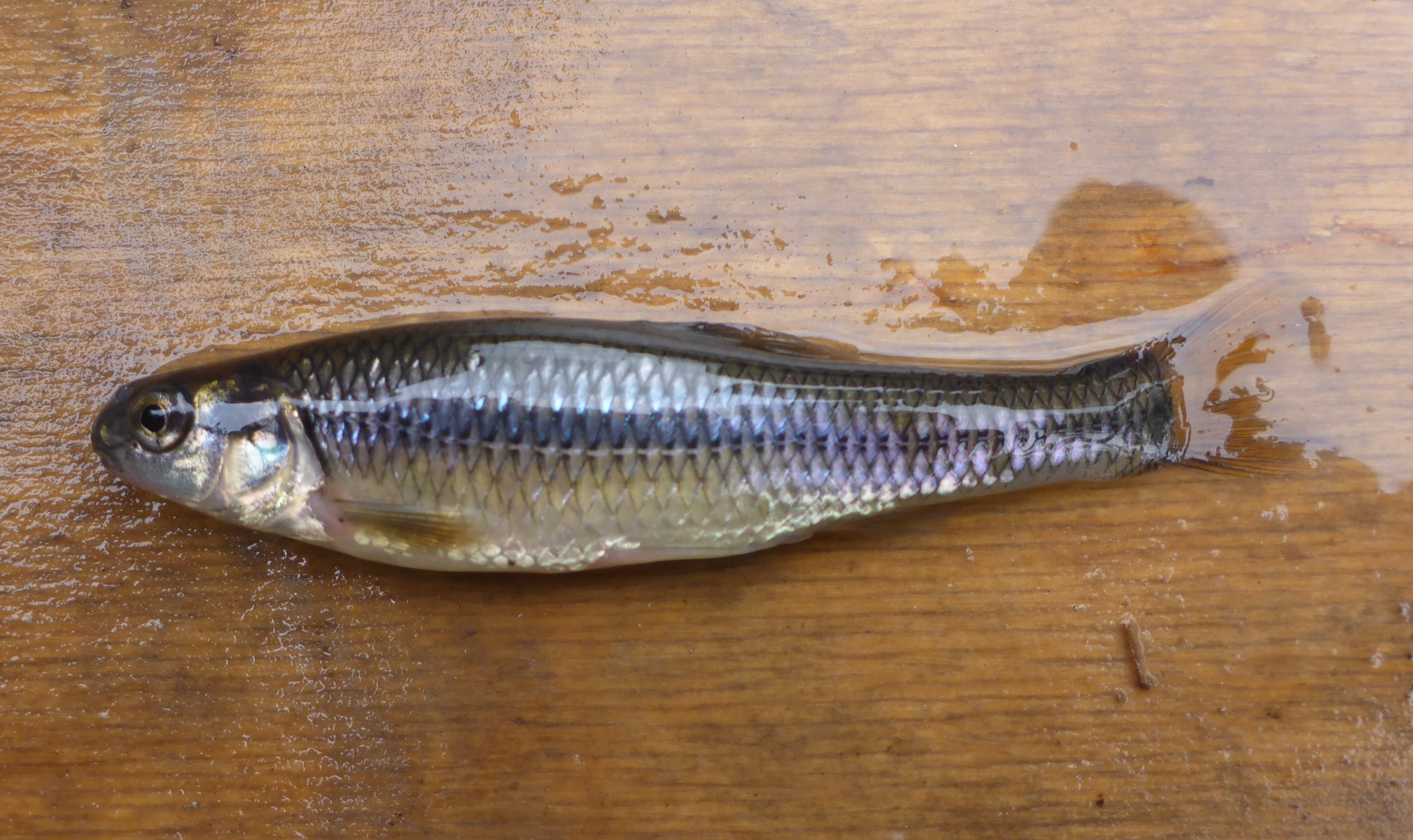Fish Iowa - Fish Species - Bluntnose Minnow

Characteristics
Bluntnose Minnows have a slender body and are almost cylindrical in cross section with a broad flat area just before the dorsal fin. Like all members of this family, they have a shortened, closely attached first ray in the dorsal fin and smaller, crowded scales in front of the dorsal fin. A prominent, dark, lateral band extends from the snout to the tail, which ends in an intense dark spot that distinguishes them from fathead and bullhead minnows. The body is pale olive-green above, with silvery-bluish sides and silvery beneath. A faint spot appears in the first few rays of the dorsal fin. The mouth is almost horizontal, slightly overhung by the snout and has no barbel. Broad, flat pharyngeal teeth, with long cutting edges, are arranged in a 4-4 pattern. The complete lateral line has 41 to 44 scales, and the intestine is about twice the length of the body. Dorsal and pelvic fins have 8 rays, while the anal fin has 7 rays, and the pectoral fins have 15 or 16 rays. Males develop a blackened head with large tubercles arranged in three rows and a bluish body during spawning.
Foods
- No results found
Expert Tip
Excellent bait fish for crappie, Yellow Perch, White Bass and other panfishes. Adapt well to aquariums.
Details
The Bluntnose Minnow is one of the most common and generally distributed fishes in Iowa, second in collections only to the Creek Chub. It is rare in collections from the Mississippi River and with the exceptions of the Lower Big Sioux, Little Sioux, Rock, and Floyd River watersheds, is completely absent from the Missouri River drainage.
The Bluntnose Minnow can live in all types of waters, but is most abundant in quiet pools and backwaters of moderate-size streams and lakes with clear, warm water, permanent flow, gravel bottoms, and some aquatic vegetation. It is a small creek species that is intolerant of high turbidity.
Spawning occurs from spring to late summer. The adhesive eggs are deposited in masses on the underside of floating logs, flat rocks, or other objects. Eggs develop into fry after about 8 to 12 days depending upon water temperature. Adults reach about 4-inches long.
Recent stream sampling information is available from Iowa DNR's biological monitoring and assessment program.
Sources:
Harlan, J.R., E.B. Speaker, and J. Mayhew. 1987. Iowa fish and fishing. Iowa Conservation Commission, Des Moines, Iowa. 323pp.
Loan-Wilsey, A. K., C. L. Pierce, K. L. Kane, P. D. Brown and R. L. McNeely. 2005. The Iowa Aquatic Gap Analysis Project Final Report. Iowa Cooperative Fish and Wildlife Research Unit, Iowa State University, Ames.
Illustration by Maynard Reece, from Iowa Fish and Fishing.
Distribution Map

Bluntnose Minnows are one of the most abundant and widely distributed cyprinids in interior streams. They are found most commonly in upper stream reaches. This minnow is rare to absent in collections from the Missouri River drainage and the Mississippi River. They appear occasional to common in fish collections from natural and man-made lakes. Their range extends into a large portion of the Mississippi River and Great Lakes basins in the central United States.
See our most recent distribution data for this species on the Iowa DNR's Bionet application.
State Record(s)
No state record exists for this species
Submit your potential recordMaster Angler Catches
No Master Angler catches currently exist for this species.
Submit your Master Angler catchFish Surveys
Tip: Click Species Length by Site, then use the dropdown to filter by fish species of interest.Where this Fish Is Found
Baileys Ford
Big Mill Creek
Bigalk Creek
Bloody Run Creek
Bohemian Creek
Coon Creek
Fountain Springs
Joy Springs
Lake Cornelia
Little Sioux River (state line to Linn Grove)
Little Turkey River
Maquoketa River (trout portion)
McLoud Run
Missouri River (Sioux City to Little Sioux)
Otter Creek
Richmond Springs
Sny Magill Creek
South Cedar Creek
Spirit Lake
Spring Branch
Spring Creek
Swiss Valley Creek
Wapsi River (Trout Section)
West Fork Grand River
Yellow River (Trout Section)